The importance of yoga has increased even more in today’s stressful life. Yoga is not only a physical activity to be free from diseases but also a means to cultivate the mind along with the body. Yoga has several benefits, along with providing physical, mental, and spiritual benefits it also reduces anger and increases endurance and positivity.
As a teacher, I have observed that some students remember things very quickly while some take a longer time to remember. It seems to us that the students are not working hard, but you will be surprised to know that the main reason behind this is the inability to concentrate, i.e. lack of concentration. Due to a lack of concentration, we are unable to concentrate on work. To do any work effectively, it is essential to have a stable mind.
Some students resort to medicines to improve their concentration, but we should adopt natural methods to increase our memory and concentration. For this, you can take the help of a healthy diet and yoga. Yoga will not only improve your concentration power but also your overall development. Everyone, whether children or adults can increase concentration by adapting yoga.
In yoga, we practice various Asanas, Pranayama, Dhyana (Meditation), Mudra, Bandha, and Shatkarma. In today’s article, I am going to describe some Asanas, Pranayama, and Dhyana. Let’s know about them in detail.
Dhyana (Meditation, ध्यान)
In simple words, meditation is the concentration of the mind at some point, person or thing, and getting absorbed in it. By continuously practicing meditation, stress-related problems are eliminated and your mind gets deep relaxation. There can be many ways of meditation. Here we are describing one of the ways that beginner can do.
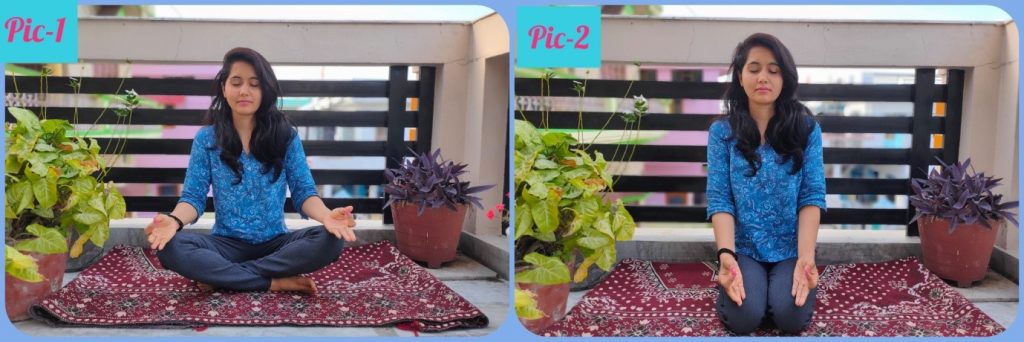
* first of all choose a clean and calm place. It is very important to sit pleasantly and steadily.
* While meditating, you can comfortably sit in any posture such as Sukhasana, Padmasana, Siddhasana or Vajrasana.
* Sit up straight and keep the reed bone straight, relax your shoulders and neck and keep the eyes closed during the whole process.
* Then we have to pay attention to our breath.
* Neither to breathe forcefully nor to forcefully exhale.
* Breathing or exhaling must occur spontaneously, that is to allow the breath to return to normal.
* Initially, a lot of thoughts will come to your mind, but later, by practicing slowly, the thoughts will decrease.
* Only to feel the breath.
* Breath will gradually become smaller in this situation, there is no thought in the mind, this situation will be the situation without thoughts.
* This is a state of meditation.
* You can do this process for 5-15 minutes.
Note- Pic-1 is shown meditating in Sukhasana and in pic-2 is shown in Vajrasana. You can sit in any posture as per your convenience.
Nadi Shodhan Pranayam or Anulom Vilom Pranayam (नाड़ी शोधन प्राणायाम या अनुलोम विलोम प्राणायम)
The Nadis are subtle energy channels in the human body. Nadi Shodhan means purification of the pulse. Nadi Shodhan Pranayama is a process of breathing that helps purification of the pulse (नाड़ियां). This pranayama is also known as nulom vilom pranayama but it varies in breathing ratio. People of all ages can do this pranayama. By doing Nadi Shodhan, one gets rid of anxiety, stress, insomnia etc.
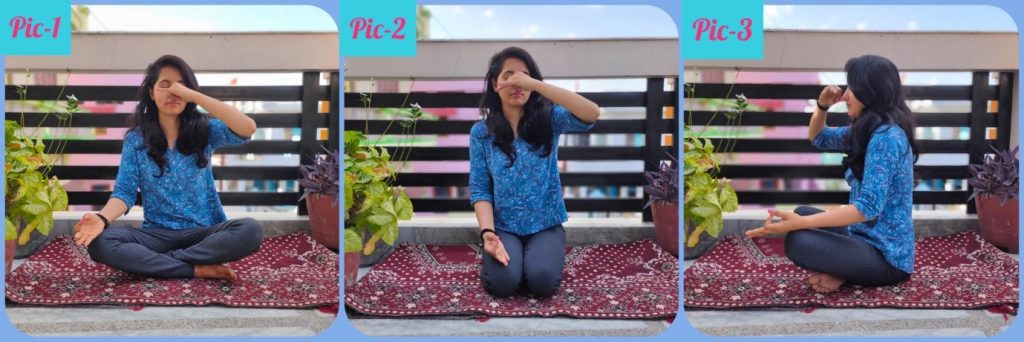
* To perform the Anulom Vilom Pranayam, first of all choose a clean place then sit in any posture such as Sukhasana, Padmasana, Siddhasana or Vajrasana.
* Sit up straight and keep the reed bone straight, relax your shoulders and neck and keep the eyes and mouth closed during the whole process.
* First of all, close the right nostril of the nose with the index finger of right hand and take long breath from the left nostril.
* After this, close the left nostril, release the long breath from the right nostril.
* While breathing, you have to focus your attention on the ‘Agya Chakra’ which is between the eyebrows.
* You can do this process for 10-15 minutes.
Note- * Pic-1 is shown Anulom Vilom Pranayam in Sukhasana and in pic-2 is shown in Vajrasana. You can sit in any posture as per your convenience.
* We can divide the breath in the ratio (1: 4: 2) according to the capacity of our body. Here 1 represents the inhalation time, 4 represents the inhalation time and 2 represents the exhalation time.
* During the process when one hand is tired we can use the other hand.
Bhramari Pranayama (भ्रामरी प्राणायाम)
Bhramari Pranayama is named after a Sanskrit word Bhramar (Bee). That is, when we do Bhramari Pranayama, a vibration or sound comes out like the sound of a bee. By doing this pranayama, one can overcome anger, anxiety and despair.
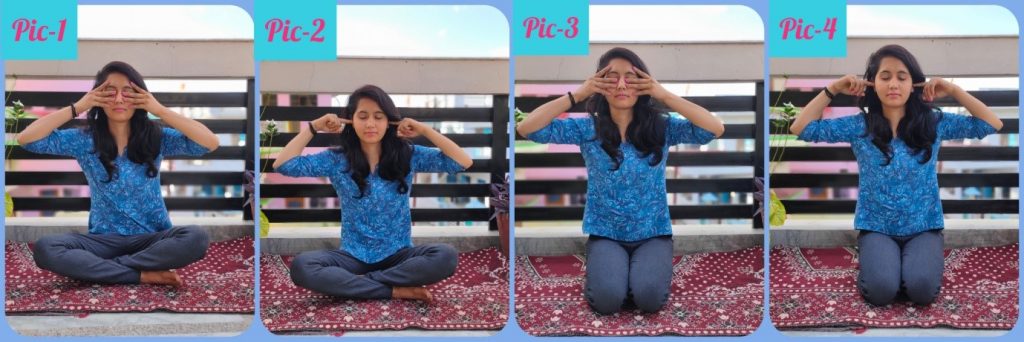
* To do Bhramari Pranayam, first of all choose a clean and calm place, and make your easy and sit in any posture such as Sukhasana, Padmasana, Siddhasana or Vajrasana.
* Sit up straight and keep the reed bone straight, relax your shoulders and neck and keep the eyes, ears and mouth closed during the whole process.
* Now spread your hands parallel to your shoulders, and bend the elbows and bring the hands near your ear.
* After this, close both your ears with both the thumbs of your hands.
* Now put the index finger of your hands on your forehead, place the middle finger on the eyes and the remaining fingers on your face.
* Now close your mouth completely and breathe in at normal speed through your nose. Then exhale through the nose making a honey-bee-like sound.
* The practice of this pranayam is to be done by closing the mouth completely.
* If the name ॐ is pronounced while exiting the breath, its benefit is increased.
* This is one round. You can repeat this pranayam continuously for 3 to 10 minutes.
Note- In Pic-1, it is shown doing Bhramari Pranayam in a Shadmukhi Mudra but you can also do it as shown in pic-2. You can sit in any posture as per your convenience.
Vrikshasana (वृक्षासन)
By doing Vriksasana, the shape of a person approaches like a tree, that’s why it is called Vriksasana. This asana shows the state of the body in a calm and static like a tree.
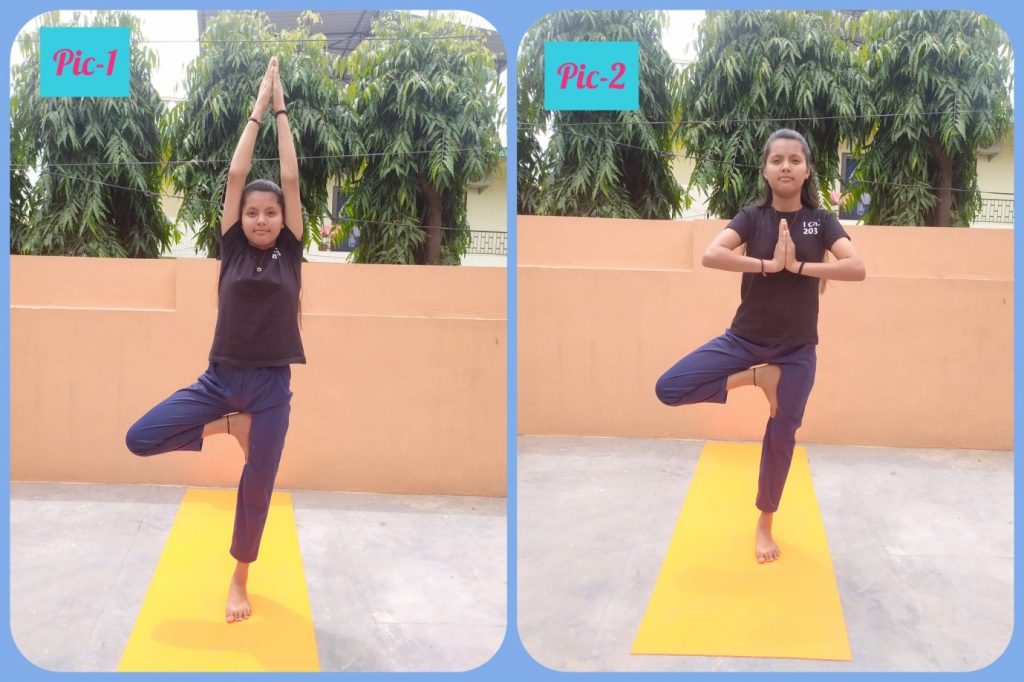
* You first have to stand upright.
* Reduce the space between the legs and keep the hands straight.
* Raise the right leg and place the right heel on the upper part of the left thigh with the help of both hands.
* The direction of the toes should be towards the bottom and press the thigh from the sole of the right foot.
* Now keep the hands in the prayer posture, lift it up and take it above the head.
* Both your hands should be adjacent to the head.
* Maintain body balance for some time.
* Keep this position as far as possible and then slowly come to the initial position.
* Now move the hands down and return to the original position.
* Then do the same process from the other leg.
* Now one round is completed. You can do 1-4 round.
Note- Vriksasana is shown in Pic-1 but you can also do it as shown in the Pic-2 for your convenience.
Natarajasana (नटराज आसन)
Natarajasan is named after Lord Shiva. Nataraja is also a name of Lord Shiva and Nataraja is the symbol of Shiva’s Tandava dance.
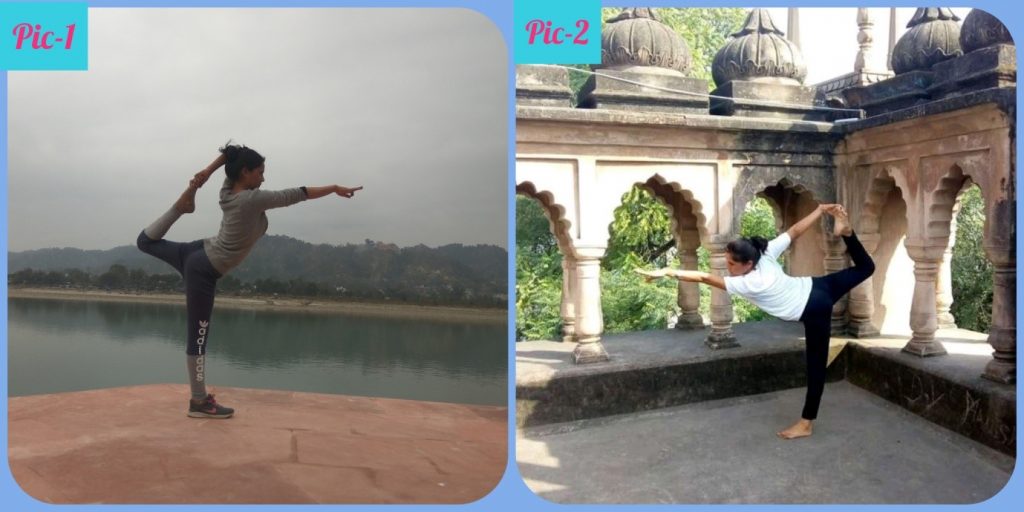
* First you stand up straight.
* Now raise your right leg, bend it with your knees and hold the ankle with the right hand and move it as far back as possible.
* Raise your left hand up and pull it straight.
* Make sure your body is stable and your eyes are in front.
* Maintain body balance for some time.
* Keep this position as far as possible and then slowly come to the initial position.
* In the same way, do it with the left leg.
* Now one round is complete.
* Now one round is completed. You can do 1-4 round.
Note- Here two variations of Natarajasan is given, but beginners can do the asana which is shown in Pic-2.
Pranayama, Dhyana, and some Asanas are described above. You need to choose a quiet corner of the house or park for pranayama and meditation. And also select the open space to do practice Asanas. Now let’s talk about what to do first. We should first micro exercise, warm-up & stretching, then do asanas, and then rest in a little shavasana, after that do pranayama letter on meditate after pranayama. But if you want to meditate only then you can do pranayama for a while, doing this will help you to meditate. Now let’s talk about what time and how long we should do yoga. It is better than you can do yoga for 30-60 minutes both in the morning and in the evening. Another important thing is that yoga should always be done on an empty stomach or after a few hours of eating when your food is completely digested.
Guys, I hope that after reading this blog, you will enrich your life by including yoga in your daily routine and make yoga as a lifestyle.
Be happy and stay healthy, Thank you!
About the Author
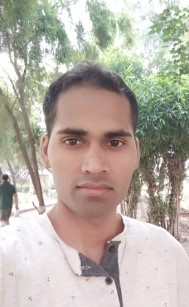
Susheel Gaur
M.A (YOGA), M.com, DYN (Diploma in Yoga & Naturopathy)
Susheel has worked as a Yoga Teacher in Kendriya Vidyalaya & various other private schools. He also provides training to individuals as a freelancer. Being a passionate yogi he has attended Patanjali & Deep yoga Sansthan swaytt sehkarita workshop in the past.
We also provide free mock tests on various examinations related to banking, SSC, Defence and more.
Get Free Online Test Series, GK updates in form of Beepedia, as well as latest updates for Bank PO, Bank Clerk, SSC, RBI, NABARD and Other Government Jobs.
займ без работызайм экспресс номер телефоназайм отличные наличные





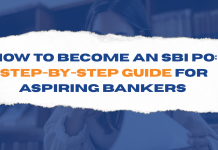









Thank you so much sir for this information of yoga. it’s really useful for me